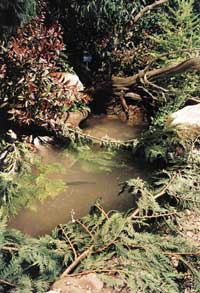Governor's Salmon Recovery Office
The Governor's Salmon Recovery Office was established by the legislature in 1998. It supports the Joint Natural Resources Cabinet. It also supports the Government Council on Natural Resources-a broad forum of representatives from the legislature, tribes, cities, counties, federal government and the ports-that reviews our efforts. Contact the Governor's Salmon Recovery Office at www.governor.wa.gov/gsro.
Publication Team:Hedia Adelsman, Chris Drivdahl, Brian Enslow, Jill Severn, Sandi Snell, Jill Williams. Assistance from Kathryn Horwath and Cheryl Vance.
Photo credits:
(Cover) Steve Schroder, Jeff Cederholm; (page 2) Bob Patterson, Charting Nature; (page 3) Ernest Keeley, Steve Schroder; (page 6) Brian Walsh; (page 7) Rollie Geppert, Brian Walsh; (page 8) Cliff Hall; (page 9) Lloyd Wright; (page 10) Steve Schroder; (page 11) Bob Everitt, Tim Waters, Michael Wilhelm; (page 12) Hal Michael, Dean Sutherland; (page 13) Hal Michael, Tony Floor; (page 14) Seattle Public Utilities; (page 15) Seattle Public Utilities; (page 16) Dick Knight volunteer with Skagit Fisheries Enhancement Group; (page 17) Chris Drivdahl, Brad Johnson/ Asotin County Conservation District; (page 18) Chris Drivdahl; (page 19) Charting Nature; (page 20) Steve Schroder; (page 21) Chris Drivdahl; (page 22) Desmond Machuca; (page 23) Blake Surprenant, Ian Edelstein; (Back Cover) Steve Schroder
This document was printed on recycled paper using soy-based inks.
To accommodate persons with disabilities, this document is available in alternative formats and can be obtained by contacting the Governor's Salmon Recovery Office at (360) 902-2231.
The Joint Natural Resources Cabinet*Special Assistant to Governor Locke for Natural Resources, Curt Smitch
Department of Agriculture, Jim Jesernig, Director Conservation Commission, Steve Meyer, Executive Director
Office of Community Development, Busse Nutley, Director
Department of Ecology, Tom Fitzsimmons, Director
Department of Fish and Wildlife, Jeff Koenings, Director
Department of Health, Mary Selecky, Secretary Interagency Committee for Outdoor Recreation, Laura Johnson, Director
Pacific Northwest Electric Power and Conservation Planning Council, Larry Cassidy, Member
Pacific Northwest Electric Power and Conservation Planning Council, Tom Karier, Member
Parks and Recreation Commission, Cleve Pinnix, Director
Puget Sound Water Quality Action Team, Nancy McKay, Chair
Office of Trade and Economic Development, Martha Choe, Director
Department of Transportation, Sid Morrison, Secretary
*In August of 1999, the Northwest Indian Fisheries Commission formally accepted the Governor's invitation to join the Joint Cabinet. They have asked Terry Williams, Executive Director of Fisheries and Natural Resources for Tulalip Tribe, to participate with the Joint Cabinet.
|
Note: |
|
Many readers have brought concerns to our attention about some of the salmon-friendly recipes in the State of Salmon Report. The Washington Department of Fish and Wildlife and others provided these homemade alternatives to chemical products. Nevertheless, we appreciate the concerns generated, and believe it's important to educate citizens on how their behaviors and activities in their own homes and yards can benefit salmon. Because it is, and will continue to be, our goal to provide the most scientifically accurate and credible information available to us, we are replacing three recipes previously found in this document with new recipes for salmon-friendly compost starter, salmon-friendly pressure washing solution, and salmon-friendly window cleaner. We also have new resource information for home gardeners who are interested in WSU-approved options. A WSU Cooperative Extension web site http://pep.wsu.edu/hortense/ contains many useful recipes for home gardeners. WSU's Cooperative Extension Bulletin #0648 is also a valuable resource you can obtain by calling 1-800-723-1763 or on-line at http://caheinfo.wsu.edu. |
Recipes for Saving Salmon
Salmon-friendly recipes (from the Washington Department of Fish and Wildlife)
Salmon-friendly pressure washing solution
2 cups mild laundry detergent
� cup vinegar
� cup lemon juice
Salmon-friendly compost starter
For quick composting with minimal odor, start with a mixture of browns (dried up plant material) and greens (kitchen scraps and grass). Never add meat scraps or bones. Do add eggshells, paper, coffee grounds and filters.
3 parts dry leaves (browns)
2 parts fresh garden weeds and grass clippings
1 part food scraps (greens)
2 parts water (or beer) added periodically
Salmon-friendly window cleaner
Use the following mixture in a spray bottle, and wipe with newspapers instead of paper towels.
� cup vinegar or 2 tablespoons lemon juice
1 quart water
Salmon-friendly all purpose cleaner
1 quart warm water
1 teaspoon liquid soap
1 teaspoon borax
� cup vinegar
Salmon-friendly drain cleaner
Try the plunger first. Next, pour � cup of baking soda followed by � cup of vinegar down the drain. Cover and let sit for 15 minutes. Pour in 2 quarts of boiling water. The clog should disappear. Do this weekly and you can prevent clogs and keep drains smelling fresh.
